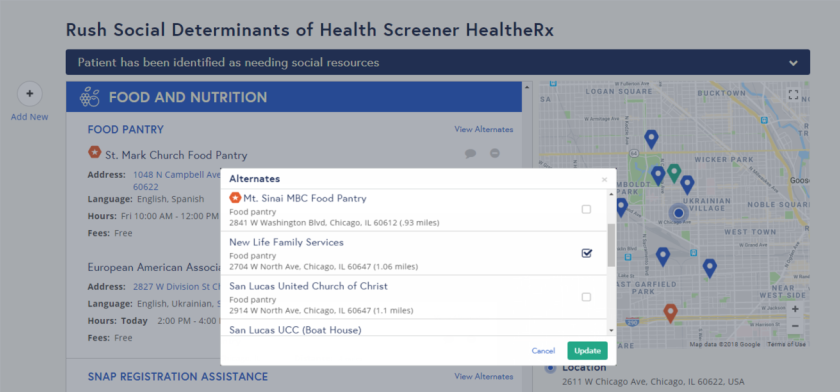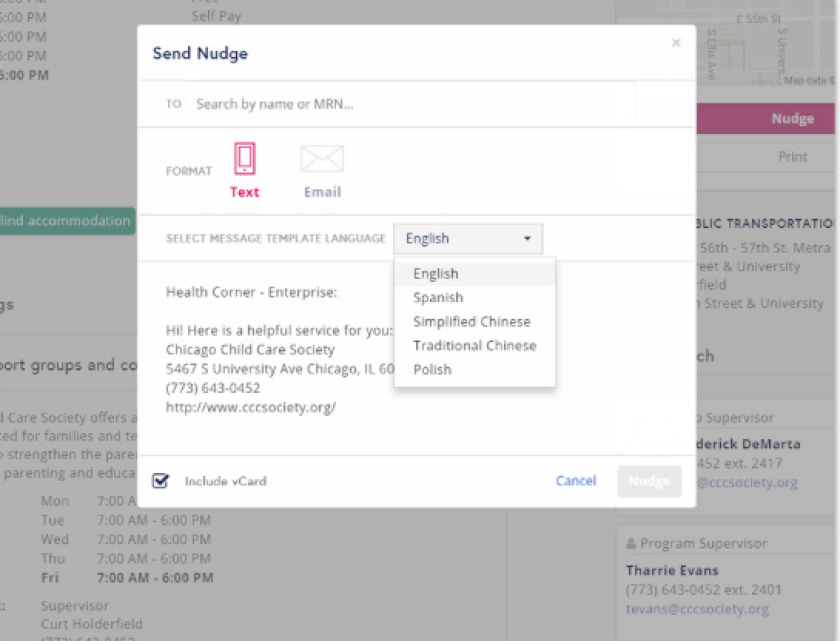In this installment of the Innovation of the Month series, we explore NowPow, a Web-enabled mobile app developed in partnership with research and policy center Chapin Hall and used by researchers at the University of Chicago to assess the use of technology to improve care for families engaged with child and family services systems.
MetroLab’s Executive Director Ben Levine sat down with Dr. Stacy Lindau, Professor of Obstetrics/Gynecology and Medicine-Geriatrics at the University of Chicago, and Founder and Chief Innovation Officer of NowPow; and Dr. Dana Weiner, Policy Fellow at Chapin Hall at the University of Chicago, to learn more.
Ben Levine: Could you please describe what NowPow is? Who is involved in this project?
Dana Weiner: NowPow refers to the suite of technological tools in use by health care, child welfare, and other social and human services systems to expedite the identification of service referrals and improve accessibility of community-based services. NowPow, inspired by the idea that “knowledge is power,” is the name of the IT company founded by Dr. Lindau to continue the work of a federal Health Care Innovation Award (HCIA).
Stacy Lindau: NowPow is an information technology company that was founded by me, along with MAPSCorps, a 501c3, to sustain an innovation called CommunityRx. CommunityRx was created with HCIA funding from the Centers for Medicare and Medicaid Services to enable health-care professionals to systematically match patients to community-based programs and services to support self-care, chronic disease management and caregiving. NowPow’s multi-sided technology platform, building on the CommunityRx experiment, is used across the U.S. to build and manage high-functioning digital community resource referral networks. Use of the system generates powerful data-driven insights to inform investments in and the development and optimization of referral networks. Chapin Hall and researchers at the University of Chicago are using a Web-enabled mobile application, developed by NowPow with Chapin Hall, to assess use of the technology to improve care for families engaged with the child and family services system.
NowPow makes it possible for case managers and social workers to e-prescribe community resources in the same way care professionals e-prescribe medicine. NowPow helps address their clients’ social determinants of health through referral matching and closed loop referrals.

Levine: What conditions motivated you to develop this particular technology approach?
Lindau: The current collaboration between Chapin Hall and University of Chicago researchers focuses on case managers who support intact families engaged with the child and family services system. These individuals routinely draw on community-based programs and services to support the adults and children in the families they serve. We are studying the feasibility of using Web-enabled mobile technology to make it easier for case managers to match families with services and to track these referrals. Child welfare systems across the country are being encouraged to shift resources toward community-based prevention services, often without the requisite tools for quickly identifying and accessing these services. Chapin Hall provides strategic consultation to many of these systems, and hoped that this effort to evaluate the impact of the tool on staff time use and work flow would yield important information that can inform transformation in other systems. The University of Chicago team is studying how information about community resources can be optimally delivered to people who need it and how the flow and spread of this information can impact both individuals and communities. The field of research focused on scalable solutions to address unmet basic and social needs largely envisions health-care systems as the driver; in this study, children and families are at the center of the ecosystem. We are interested to learn how optimizing community resource referral activities can impact that important ecosystem.
Levine: How did the partnership between Chapin Hall and the University of Chicago come about? Were any government and community organizations involved in the process?
Weiner: In 2004 I developed the Illinois Statewide Provider Database, and later served as a consultant to the University of Chicago’s 2012-15 CommunityRx experiment led by Dr. Lindau. Now a policy fellow at Chapin Hall, I collaborated with Michael Stiehl and Nucha Isarawong to compete in and win the Booth School of Business App Challenge in spring of 2017, with a prototype mobile app for child welfare resource referrals. Chapin Hall allocated their winnings to iterate the NowPow tool as a mobile-optimized technology customized for child welfare users, and proposed with Dr. Lindau to test the new tool with support from the Chapin Hall-University of Chicago Joint Research Fund (JRF). We [Lindau and Weiner] were awarded a grant from the JRF to study the feasibility of iterating the CommunityRx solution to support child and family services. Partners on this effort include the Illinois Department of Children and Family Services Intact Family Services Program (Julia Miller and Anne Gold) as well as OMNI Youth and Family Services (Doryce McCarthy).
Levine: What was the most surprising thing you learned during this process?
Weiner: First, child welfare systems have evolved outside of many of the technological advancements that have improved health-care service delivery. Substantial efforts are needed to help tech developers understand the dynamics of the child welfare service delivery context and processes, and to develop modifications that “work” within that context. Similarly, the second lesson is that as child welfare providers shift to using technology (e.g., tablets, new software) the other protections put in place may impede the functioning of technology. Just as we check for contraindications and drug interactions when prescribing medications, so must we inventory existing technology to ensure that the tool we “prescribe” can function effectively on a platform that also protects privacy and transmits sensitive information to and about families.
Lindau: We also learned that it is feasible, in a relatively short time frame, to partner with a child welfare agency to implement a mobile technology to facilitate the community resource referral workflow. Implementation required engagement between researchers, government and frontline caseworkers; iteration of the technology to fit with caseworker workflows and needs; a brief training and availability of ongoing support; and bidirectional communication between the implementation team and frontline end users.
Similar to Dr. Weiner’s point, we learned how relevant and applicable a technology solution that better connects clients to resources in their community is across sectors. Built initially to serve health-care institutions, this partnership has shown that access to a comprehensive resource directory that also captures key eligibility and intake processes is applicable and can be implemented far more broadly.

Levine: Where will this project go from here?
Weiner: Data analysis is currently underway. Our next steps will be to share findings back with OMNI Youth and Family Services, the partnering agency, and to disseminate findings via presentation and publication. Our current study establishes the feasibility of working together with an agency and case managers engaged in supporting intact families involved with the child and family welfare system. Based on these findings, our aim is to extend and expand our research to understand the mechanisms through which a community resource referral solution impacts care and outcomes for these families. Chapin Hall routinely receives inquiries from child welfare systems interested in leveraging the technology to improve the efficiency and effectiveness of service delivery. Chapin Hall is working with NowPow on collaborative presentations to these jurisdictions to ascertain interest and customize plans.
About MetroLab: MetroLab Network introduces a new model for bringing data, analytics, and innovation to local government: a network of institutionalized, cross-disciplinary partnerships between cities/counties and their universities. Its membership includes more than 35 such partnerships in the United States, ranging from midsize cities to global metropolises. These city-university partnerships focus on research, development, and deployment of projects that offer technologically- and analytically-based solutions to challenges facing urban areas including: inequality in income, health, mobility, security and opportunity; aging infrastructure; and environmental sustainability and resiliency. MetroLab was launched as part of the White House’s 2015 Smart Cities Initiative. Learn more at www.metrolabnetwork.org or on Twitter @metrolabnetwork.








